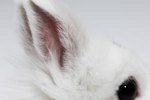Some rabbits appear to have extra-thick necks, with a flap of skin under the chin called a dewlap. The breed standard for some breeds of rabbit requires a dewlap, while for others it's considered a fault or disqualification. Usually only female rabbits have dewlaps.
Dewlap Purpose
The dewlap appears in female rabbits who are ready to give birth; it facilitates building a nest. The loose flap serves as an easy-access place to pull fur from, to line the nest and keep the babies warm. Some males also have small dewlaps, but the trait is not common.
Breeds With Dewlaps
Females of some breeds need to have dewlaps in order to meet breed standards. They include Flemish Giants, Californians and French Lops -- even male French lops are allowed to have small dewlaps, although the feature is not favorable.
Breeds that are allowed but not required to have dewlaps include Giant Chinchillas, German Lops, Miniature Lops and New Zealands.
By contrast, some breeds are not supposed to have obvious or excessive dewlaps, including Havanas, Self Rexes, Englishes, Champagnes d'Argent and Giant Papillons.
Health Concerns
If a rabbit has an oversize dewlap, she may be overweight. The large dewlap in turn makes it difficult for her to eat and drink, which can cause starvation and dehydration. It can also lead to wet dewlap, or moist dermatitis, which occurs when the dewlap becomes soggy while drinking. Excess salivation can also cause wet dewlap, but so can drinking from a water bowl -- use drinking tubes or automatic watering systems to combat the issue.
Don't take wet dewlap lightly, since it can result in inflammation, infection, maggot infestation or hair loss. If the area turns green, it's likely due to Pseudomonas bacteria. To treat this infection, you should see the vet, since it may be necessary to gently clip the hair down to the skin. The vet may prescribe or recommend an antiseptic dusting powder. In more serious cases, the vet may give an antibiotic injection.
Writer Bio
Heather Vale is a writer, interviewer and seasoned journalist. She has authored news, entertainment and informational programming in TV, radio, print and online media. She is also a certified childhood fitness and nutrition specialist with a background in mind-body-spirit health, self-help, business, technology and pet breeding. Vale holds a Bachelor of Fine Arts in visual arts from York University.





